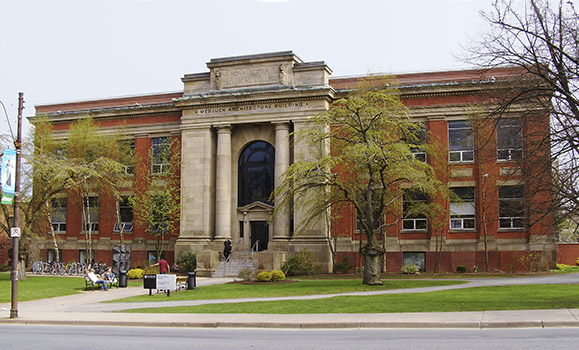
The abandonment of my alma mater is something that I have wanted to explore and reflect upon for quite some time. I kept putting it off because I was unable to come to grips with my feelings. I am hoping that writing about it will somehow be therapeutic, if not cathartic. Please allow me to explain…
Back in the mid 1970’s I was accepted into Memorial University. I had just graduated from Prince of Wales Collegiate high school and harboured a fervent desire to become an architect. (God only knows why!)
I had a keen grasp of the prerequisites for Architecture School, and regarded MUN purely as a means to an end. The plan was to get in there, find some discipline I enjoyed, do well in it, get good grades and bingo – get accepted into Architecture School.
I was fortunate. MUN had all kinds of great things to offer. I took an interest in computers – learned Basic and Fortran programming languages. My love of English Literature had me moving through various classes that eventually brought me to a creative writing class. This proved to be one of the best post-secondary courses I ever experienced.
My major evolved into a wholly different discipline: Geography. I was inspired by some brilliant professors in that department. Indicative of the relationships I formed is the fact that I am still well acquainted with many of these professors today. In fact, the Head of the Geography Department authored my recommendation for Architecture School, which was likely my ticket there. Dr. Scarlett wrote: “The Geography Department’s loss will invariably be a gain for Nova Scotia Technical College”. I owe him my career. I don’t take that lightly.
So off I go to Halifax where I will spend the next four years of my young life. My first degree was Bachelor of Environmental Design Studies. It was granted by Nova Scotia Technical College. It (although I did not know it at the time) was apparently going through a bit of a personality crisis. People of influence felt that the “college” moniker was insufficient for what was essentially a university. Fair enough. After considerable public discussion and soul-searching, the Technical University of Nova Scotia was the name adopted (TUNS). Therefore, two years later, when I was granted my professional degree, Bachelor of Architecture, it was from the newly christened institution.
That’s the historical foundation of the dilemma. I left Halifax and struggled for many years to become a credible (i.e. employed) architect. I went through an internship program and eventually became a registered professional in Newfoundland at the tender age of twenty-four. I lost touch with TUNS in the desperate attempts to establish myself. Or perhaps TUNS lost touch with me as I moved around quite a bit in those early years. I spent one full year practicing outside the province and over three years practicing outside of Canada. It was often tough making ends meet. Money was tight. Paying off over $50K in student debt was a challenge. My first mortgage was only $60K!
Then, when I finally settled here with what was promising to be a successful career, TUNS became obsolete. In 1997 it merged with Dalhousie. Initially, there remained some semblance of distinction, but as the years progressed the Dalhousie monster ingested and digested the few remaining vestiges of what was fondly remembered as “Tech”. My alma mater essentially dissolved.
As an alumnus of TUNS, I was never once asked for a donation to that institution. Just as well. During that first sixteen years of my professional life, there were times when I struggled to feed and house my family – let alone make charitable donations, no matter how worthy the cause.
But somehow, when I became a partner in a well-established firm, Dalhousie tracked me down. I went on to become the managing director of my own firm, but in the intervening years I ignored Dal’s overtures for charitable contributions. There are a number of reasons for this:
- I did not graduate from Dalhousie and I have never set foot in that institution (despite the merger with TUNS).
- I know full well that any financial contribution I make as an alumnus will be spent in Nova Scotia (a province with which I have no personal connection whatsoever).
- Dalhousie has no presence here in Newfoundland and Labrador and makes little or no effort to promote architecture beyond its own border. (I refer to architecture in particular because MUN has no School of Architecture. Many other faculties are duplicative. Many, like law and dentistry, are coveted. But viticulture and enology are higher priorities than architecture.)
So this seems like a personal problem. A man without an alma mater. An identity issue. Some may say I’m just too cheap to answer Dalhousie’s calls. But it is far more than that.
Architecture is a discipline and an art that has little appreciation in Newfoundland and Labrador, except for a very limited few who could likely be tallied on the fingers of one hand. The root of this problem lies with our schools and post-secondary education systems. This leads to apathy throughout the general populace. We see awful buildings being erected that are not only unsustainable, but are of poor quality materials, unsuitable for our climate. Many of these designs are the work of architects who are not located here, and who are far from intimate with the vagaries of our climate. Others are the result of developers who, knowing they won’t be criticized for putting up a building bereft of any redeeming aesthetic quality or public engagement merit, just don’t care.
And we see buildings of great cultural or commercial value demolished because it is far more financially viable to remove their entirety to Robin Hood Bay landfill than it is to reuse or repurpose. Then a cheap structure is built only to be torn down again in twenty years because it has no value. This is a cycle that has been encouraged and in fact lauded by municipal and provincial governments. It has led to a provincial building procurement policy that awards building design commissions on the basis of lowest cost as opposed to vision, quality performance or expertise. And, it has led to the promotion of P3 procurement (Public Private Partnership) which systematically excludes local design input.
And finally, this ailment of which I speak is so insidious that not a single architect is employed in the provincial or municipal civil service – something that people from outside this province would find remarkable if not utterly shocking. Not a soul to advise on how a building should be procured and constructed so that it is in the public’s best interest, let alone someone to advise on commodity and delight!
Our politicians and elected officials display the most uncanny ignorance of something that the rest of civilization holds very dear. The few struggling architects that make this province their home are unable to affect any change or advocate for quality design because they are treated like a bizarre fringe group by the provincial bureaucrats. Bureaucrats that swim in a pool filled with engineers and accountants that has never been drained.
That, my friends, is a problem. We, in this province, have built cities and towns around us that have no regard for sustainability, accessibility, physiology, mental health, physical health, cooperation, wayfinding, multi-culturalism, or the planet. Worse still, our buildings do very little for our imagination or our dignity.
Can Memorial University and Dalhousie get together to discuss this problem? I doubt it. But it would be a good start. I for one would open up my wallet for the cause.
